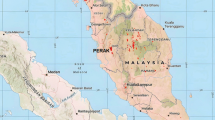Abstract
Pocosins are nonalluvial Coastal Plain wetlands with strongly acidic and nutrient-poor soils, and a generally dense shrub layer composed of a characteristic suite of species. A diversity of pocosin vegetation occurs in the Carolinas, occupying a range of topographic, hydrologic, geographic, and pedologic situations. To help clarify this diversity, a classification was developed, integrating vegetation, site factors, and ecological dynamics. Eight community types are recognized — Low Pocosin, High Pocosin, Pond Pine Woodland, Peatland Atlantic White Cedar Fores, Bay Forest, Streamhead Pocosin, Streamhead Atlantic White Cedar Forest, and Small Depression Pocosin. White cedar forests, while they have not usually been considered pocosins, occupy the same sites as pocosins in temporally shifting mosaic determined by catastrophic fire events and share many species. The eight pocosin types can be distinguished by vegetation, peat depth, topographic setting, fire regime, water source, size, and shape. Pocosins occur in five main topographic and physiographic situations: peat domes of the outer Coastal Plain, Carolina bays primarily of the outer and middle Coastal Plain, headwaters of Coastal Plain blackwater streams (especially in the Sandhills), broad poorly-drained swales in the outer and middle Coastal Plain, and various isolated small depressions throughout the Coastal Plain.
Similar content being viewed by others
Literature Cited
Biswell, H.H. and J.E. Foster. 1942. Forest grazing and beef cattle production in the Coastal Plain of North Carolina. NC Agricultural Experiment Station Bulletin No. 334, Raleigh, NC, USA.
Buell, M.F. and R.L. Cain. 1943. The successional role of white cedar (Chamaecyparis thyoides) in southeastern North Carolina. Ecology 24: 85–93
Christensen, N.L. 1981. Fire Regimes in Southeastern Ecosystems.In: Fire Regimes and Ecosystem Properties, Proceeding of the Conference, USDA Forest Service General Technical Report WO-26.
Christensen, N. L. 1988. Vegetation of the Southeastern Coastal Plain.In: M.G. Barbour and W.D. Billings (eds.) North American Terrestrial Vegetation. Cambridge University Press, Boston, MA, USA.
Christensen, N.L., R. Burchell, A. Liggett, and E. Simms. 1981. The structure and development o pocosin vegetation.In C.J. Richardson (ed.) Pocosin Wetlands: An Integrated Analysis of Coastal Plain Freshwater Bogs in North Carolina. Hutchinson Ross Publishing Company, Stroudsburg, PA, USA.
Cowardin, L.M., V. Carter, F.C. Golet, and E.T. LaRoe. 1979. Classification of Wetlands and Deepwater Habitats of the United States. Office of Biological Services, Fish and Wildlife Service, Washington, DC, USA. FWS/OBS-79/31.
Hughes, R.H. 1957. Response of cane to burning in the North Carolina Coastal Plain. North Carolina Agricultural Experiment Station Bulletin No. 402, Raleigh, NC, USA.
Kologiski, R. 1977. The Phytosociology of the Green Swamp, North Carolina. North Carolina Agricultural Experiment Station Technical Bulletin No. 250, Raleigh, NC, USA.
Moore, J.H. and J.H. Carter III. 1988. Habitats of White Cedar in North Carolina.In: A.D. Lademan (ed.) Atlantic White Cedar Wetlands. Westview Special Studies in Natural Resource and Energy Management. Westview Press, Boulder, CO, USA.
Otte, L.J. 1981. Origin, Development, and Maintenance of the Pocosin Wetlands of North Carolina. Unpublished report to NC Natural Heritage Program and The Nature Conservancy, Raleigh, NC, USA.
Schafale, M.P. and A.S. Weakley. 1990. Classification of the Natural Communities of North Carolina, Third Approximation. NC Natural Heritage Program, Raleigh, NC, USA
Snyder, J.R. 1980. Analysis of Coastal Plain Vegetation, Croatan National Forest, NC. Veroeffentlichungen des Geobotanischen Institutes der Eidgenossische Technische Hochschule, Stiftung Ruebel, Zurich. 69. Heft: 40–113
Wilbur, R.B. and N.L. Christensen. 1983. Effects of fire on nutrient availability in a North Carolina Coastal Plain pocosin. American Midland Naturalist 110:54–61
Woodwell, G.M. 1956. Phytosociology of Coastal Plain Wetlands of the Carolinas. M.S. thesis, Duke University, Durham, NC, USA
Author information
Authors and Affiliations
Rights and permissions
About this article
Cite this article
Weakley, A.S., Schafale, M.P. Classification of Pocosins of the Carolina Coastal Plain. Wetlands 11 (Suppl 1), 355–375 (1991). https://doi.org/10.1007/BF03160756
Received:
Revised:
Accepted:
Issue Date:
DOI: https://doi.org/10.1007/BF03160756




